Does your WordPress login page keep refreshing and redirecting when you try to log in to your website?
This issue locks you out of the WordPress admin area, making you unable to work on your website.
In this article, we will show you how to fix the WordPress login page refreshing and redirecting issue.
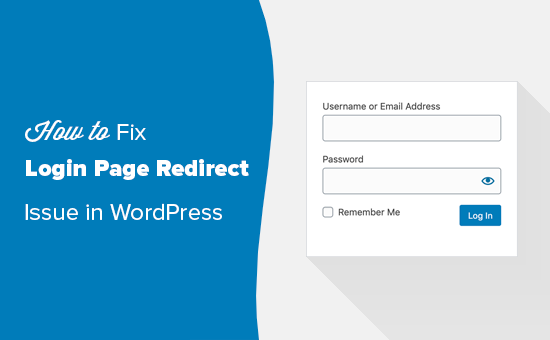
What Causes the Login Page Refresh and Redirect Issue in WordPress?
The WordPress login page refresh and redirect error is usually caused by incorrect WordPress URL settings or failure to set login cookies.
Normally, when you log in, WordPress validates your username and password and then sets a login cookie in your browser. After that, it redirects you to the WordPress dashboard.
If WordPress fails to set the login cookie correctly or your WordPress admin area URL is incorrect, then you will be redirected back to the login screen instead of the admin dashboard.
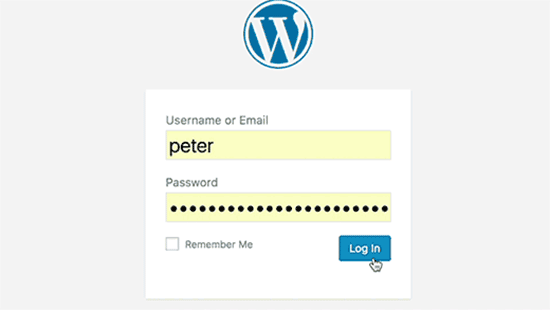
Login issues can also be caused by different WordPress errors, such as the error establishing database connection, internal server error, or the white screen of death.
With that in mind, let’s troubleshoot and fix the WordPress login page redirect and refresh issue. You can use these quick links to jump to a specific method:
Note: If you want to try the advanced steps in this WordPress tutorial, then please create a backup of your site first. See our guide on how to manually create a WordPress database backup.
Video Tutorial
If you don’t like the video or prefer the written version instead, then please continue reading.
Method 1: Clear Cookies to Resolve Login Issues
WordPress uses cookies for login authentication, so the first step in troubleshooting WordPress login issues is the simplest one. You will need to clear your browser cookies and cache.
In Google Chrome, simply click on the browser settings menu and then select More Tools » Clear Browsing Data.
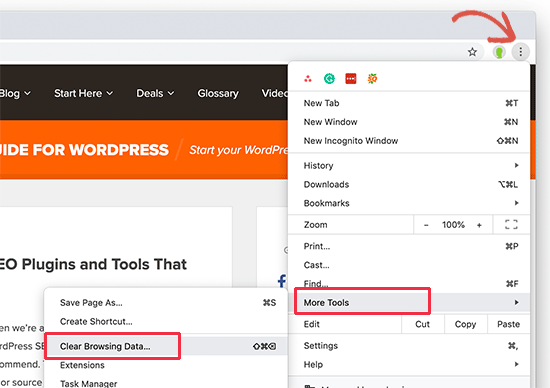
This will launch the Chrome Settings page with a ‘Clear Browsing Data’ popup displayed on the screen.
From here, you need to select the ‘Clear cookies and other site data’ and ‘Cached images and files’ options.
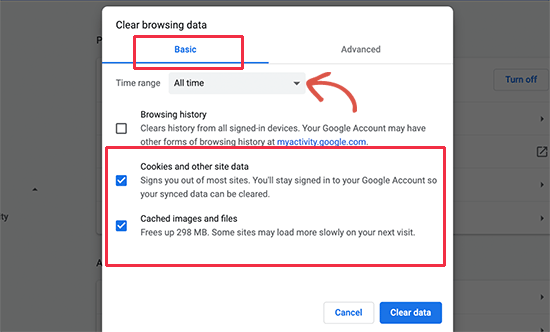
Next, click on the ‘Clear data’ button, and Google Chrome will clear the browser cache.
Also, make sure that your browser has cookies enabled. After doing that, restart your browser and then try to log in. This should fix the issue for most folks.
We have a complete guide with screenshots showing how to clear the cache and cookies in all major browsers.
Method 2: Update WordPress URL Settings
WordPress comes with settings for the URL of your website and the URL of your WordPress installation.
If you had access to your WordPress admin area, then you could see this option on the Settings » General page.
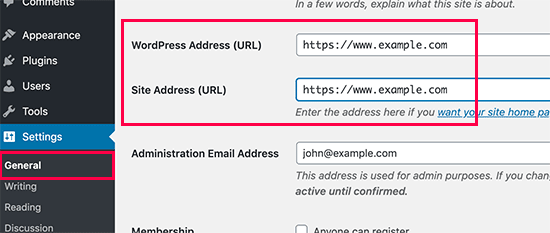
If these URLs are incorrect, then WordPress will redirect you back to the login page.
Since you are unable to access the WordPress admin area, you will need to edit the wp-config.php file to fix this issue.
The wp-config.php file is a special file in WordPress that contains your important WordPress settings. You can access it using an FTP client or via the File Manager app in your WordPress hosting account dashboard.
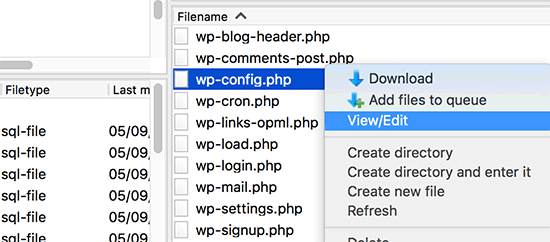
You will find the wp-config.php file in your site’s root folder. Simply edit the file and paste the following lines of code just before the one that says, 'That's all, stop editing! Happy publishing'.
define('WP_HOME','https://www.example.com');
define('WP_SITEURL','https://www.example.com');
Don’t forget to replace ‘example.com’ with your own domain name.
After that, save your changes and upload the file back to your website.
You can now visit your WordPress website and try to log in. Hopefully, this will have fixed the issue for you. If it didn’t, then continue reading for additional troubleshooting steps.
Method 3: Delete .htaccess File in WordPress
Sometimes, the .htaccess file can get corrupted, which can result in internal server errors or the login page refreshing error.
Simply access your website using an FTP client or via the File Manager app in your hosting provider’s dashboard.
Once connected, locate the .htaccess file in the root directory of your website and download it to your computer as a backup.
If you can’t find your .htaccess file, this guide on why your .htaccess file may be missing can help you.
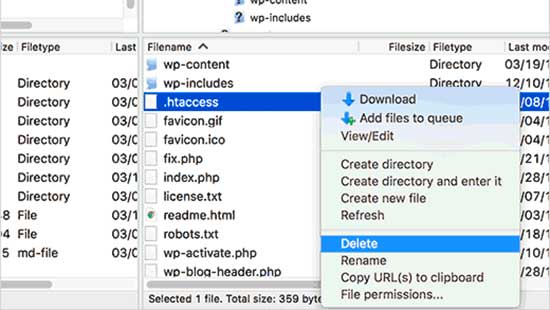
After that, go ahead and delete the .htaccess file from your website.
Next, open the wp-admin directory, and if there is a .htaccess file there, then go ahead and delete it as well.
You can now try to log in to your WordPress website. If you succeed, then this means that your .htaccess file was stopping you from logging in to WordPress.
Once you are logged in, simply go to the Settings » Permalinks page in the WordPress admin panel and click on the ‘Save’ button without making any changes. This will generate a new .htaccess file for your website.
Method 4: Deactivate All WordPress Plugins
Sometimes, WordPress plugins can cause this issue, especially if there is a conflict between two plugins.
To easily deactivate all your WordPress plugins, connect to your website using an FTP client or via the File Manager app in your web hosting account dashboard.
Once connected, go to the /wp-content/ directory. Inside it, you will see a folder named ‘plugins’. This is where WordPress installs all your plugins.
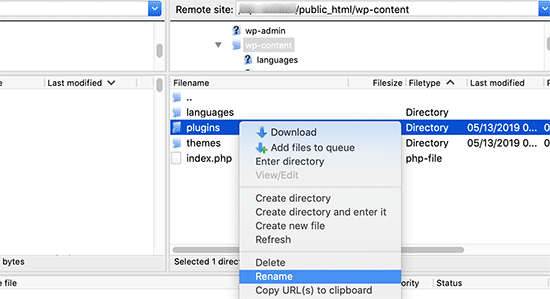
Simply rename the plugins folder to ‘plugins_backup’. This will deactivate all WordPress plugins installed on your website.
We also have a detailed tutorial on how to deactivate all WordPress plugins when the WordPress admin is inaccessible.
Once you have deactivated all plugins, try logging in to your WordPress site. If you succeed, then this means that one of your plugins was causing the issue.
Method 5: Revert to the Default Theme
WordPress themes can also cause conflicts after upgrading to a newer version of WordPress or the theme itself. To find out whether the problem is being caused by your theme, you will need to deactivate it.
The process is similar to deactivating plugins. Connect to your website using an FTP client. Then, you must go to /wp-content/themes/ directory and rename your current theme directory to ‘themes_backup’.
Once you have done that, then try logging in again. If you succeed, then this means your theme was causing the issue.
You can now reinstall a fresh copy of your theme to see if this resolves the issue. If the problem reappears, then you will need to contact your theme’s support or switch to a different WordPress theme.
Method 6: Reinstall WordPress Core
In rare cases, the persistent login page refresh issue might be caused by corrupted WordPress core files.
These core files are the foundation of your WordPress website and manage essential functionalities. If these files become damaged or overwritten with incorrect code, it can lead to various errors, including login problems.
First, head over to WordPress.org and download the latest version of the software. Once downloaded, unzip the file on your computer. This will create a folder named ‘wordpress’ containing all the necessary files for the reinstall.
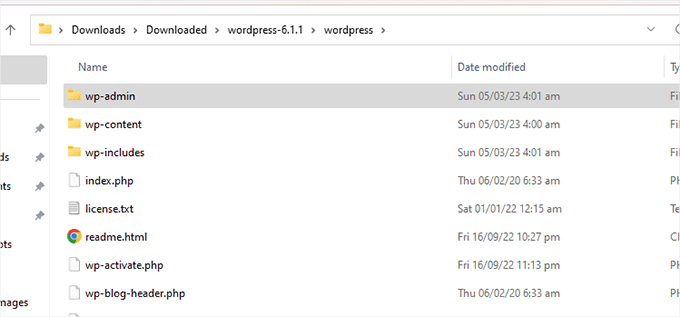
Next, you’ll need to connect to your website using an FTP client or the file manager provided by your hosting company.
Once connected, navigate to the root folder of your website. This is the main directory that contains folders like wp-admin, wp-content, and wp-includes.
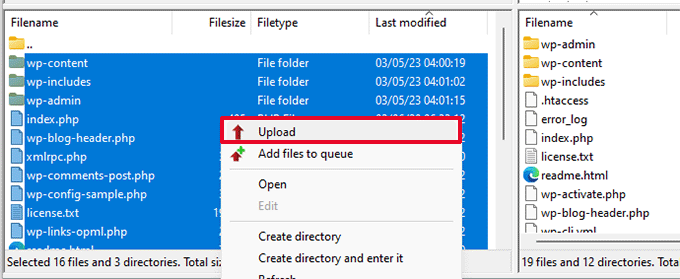
At this stage, grab all the files from the ‘wordpress’ folder on your computer and upload them to your website’s root directory.
Your FTP client will ask you to confirm overwriting any existing core files.
Since you’re deleting corrupted WordPress core files and replacing them with new ones, choose ‘Overwrite’ and select the option to ‘Always use this action’ to avoid needing to confirm each file individually.
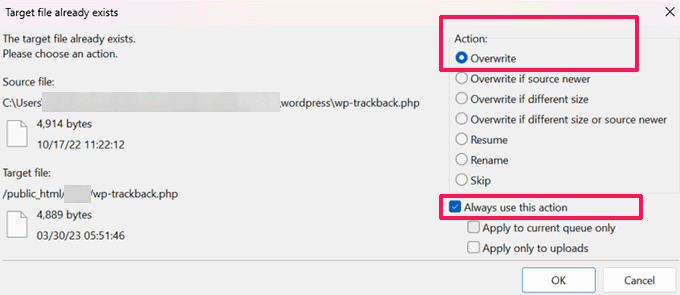
Finally, click ‘OK’ to begin the upload process. Your FTP client will replace the core WordPress files on your website with the fresh ones from your computer.
Once the upload is complete, visit your website to see if the error is fixed. If the login issue is caused by a corrupted core file or malware, the error message should be gone, and you should be able to log in successfully.
Learn More WordPress Troubleshooting Solutions
Are you experiencing other common WordPress errors and need to find a way to fix them? Here are other articles you can check out:
- How to Fix Error Too Many Redirects Issue in WordPress
- How to Easily Fix This Site Can’t Be Reached Error in WordPress
- How to Fix ‘The Site Is Experiencing Technical Difficulties’ in WordPress
- How to Fix WordPress Posts Returning 404 Error (Step by Step)
- How to Fix the Mixed Content Error in WordPress (Step by Step)
- How to Fix the Invalid JSON Error in WordPress (Beginner’s Guide)
- How to Find and Access WordPress Error Logs (Step by Step)
- How to Fix WordPress Not Sending Email Issue
We hope this article helped you resolve the WordPress login page refreshing and redirecting issue. You may also want to see our complete WordPress troubleshooting guide or check out our top picks for the best WordPress plugins and tools to grow your site.
If you liked this article, then please subscribe to our YouTube Channel for WordPress video tutorials. You can also find us on Twitter and Facebook.





Syed Balkhi says
Hey WPBeginner readers,
Did you know you can win exciting prizes by commenting on WPBeginner?
Every month, our top blog commenters will win HUGE rewards, including premium WordPress plugin licenses and cash prizes.
You can get more details about the contest from here.
Start sharing your thoughts below to stand a chance to win!
Stef says
None of this worked for any of the sites we tried this on
WPBeginner Support says
If none of the methods in this article were able to solve the issue on your site we would recommend reaching out to your hosting provider and they should be able to see if there is a specific error on their end.
Admin
Amnon Jakony says
Deleting htaccess file worked fine for me…
WPBeginner Support says
Glad to hear it was able to help you!
Admin
Harry k says
Thanks for this video and the post. I tried above all of your methods but none of them fixed the issue. read the comment and found a solution as below. Edit HTTPS to HTTP.
define(‘WP_HOME’,’https://example.com’);
define(‘WP_SITEURL’,’https://example.com’);
to
define(‘WP_HOME’,’http://example.com’);
define(‘WP_SITEURL’,’http://example.com’);
WPBeginner Support says
The issue with this method would be that your site would start to show the not secure message as your site would not be using HTRTPS. This can be a temporary workaround but you would want to update your site to use HTTPS after you are able to log in.
Admin
Tobias says
No luck none of them worked
WPBeginner Support says
If none of the methods from this article are working for you, we would recommend reaching out to your hosting provider for them to check if there are any errors on their end.
Admin
Salah says
Thanks a lot,
You saved my day,
I have changed the file wp-config.php as described in the tutorial and that worked for me.
My best regards.
WPBeginner Support says
Glad to hear our guide was helpful!
Admin
Robert clancy says
I messed around with the Update WordPress URL Settings
and that was a world of pain to correct as it took my whole site down. I had to correct it through changing the config settings using FTP.
WPBeginner Support says
The settings are definitely powerful and can cause issues if you change them incorrectly. Glad you were able to fix the issue using FTP!
Admin
DK John says
Your first method worked for me. Thank you for this magical guide
WPBeginner Support says
Glad our guide was helpful!
Admin
David Kuteesa says
Tried all and none worked. Here is what worked:
Went to wp-config.php and set define( ‘WP_DEBUG’, false); to define( ‘WP_DEBUG’, true );
Tried logging in again and got “usermeta table missing” error.
Thats when I realised I had a missing table. Got it from another installation and changed the table prefix to meet current db.
Worked immediately
WPBeginner Support says
Thank you for sharing this, for most beginners we recommend reaching out to their hosting provider if our recommendations do not work as they can check for less beginner friendly errors.
Admin
Stian says
Thank you – that tip about restoring the admin page by adding two lines of code in the config file seems to work nicely (still crossing fingers), but I have hope now, which I didn´t earlier.
WPBeginner Support says
We hope it helps!
Admin
WPBeginner Support says
Glad our guide could help and if you hadn’t set up SSL before changing to https that would definitely be the most likely cause.
Admin
branhampaul says
Thank You, it worked.
I initially had the siteurl & wp address url changed to “https”, and this made me unable to log-in my dashboard. Maybe because I had not ssl at my host set-up.
Re-changing the “https” to “http” helped me log-in back.
Bryan Veloso says
Everything didn’t work. But after downgrading my PHP from 7.4 to 7.2, I was able to login.
Kinda weird, now I’m using an older PHP version.
Did you encounter an issue similar to mine? I want to use the newer PHP version, but it doesn’t let me login in wp-admin.
WPBeginner Support says
More than likely, you may have a plugin causing a conflict, you would want to start by following our troubleshooting guide below:
https://www.wpbeginner.com/beginners-guide/beginners-guide-to-troubleshooting-wordpress-errors-step-by-step/
Admin
Alisha says
This issue has never happened to me before, but the 2nd / plugin option worked for me right away.
This website is a lifesaver! Thank you so much!
WPBeginner Support says
Glad our guide was helpful
Admin
Øivind says
Thank you! The wp-config.php-metod worked for me!
WPBeginner Support says
Glad our recommendation was able to assist
Admin
Ruta says
I tried some of these steps, but the problem turned out to be elsewhere: my site was setup as a ‘multisite’ but in wp-config file it said ‘subdomain_install’ as ‘false’, when I changed it to ‘true’, I could login to the site normally without redirects
WPBeginner Support says
Glad you found the solution to the issue
Admin
Jerry says
This was also my problem! I tried all the steps mentioned in the article, but after changing the ‘subdomain_install’ from false to true in the wp-config.php file it worked!!
Thanks!!
Joe says
I have been trying to solve this for MONTHS… Thanks to your comment, I was able to fix it in about 10 seconds. Thank you so much for sharing!
This should be included in the tutorial.
Brayton Scott says
Awesome, and simply tutorial. 1st suggestion fixed my site.
WPBeginner Support says
Glad our recommendation could help
Admin
Fraser says
I followed the instructions to deactivate all plugins and I now have access to wp-admin again! The instructions were easy to follow, and thanks so much for putting them out there.
WPBeginner Support says
Glad our article was helpful
Admin
Sachin Baikar says
Thanks for this great help. The plugin folder renaming worked for me. There was an issue with one of the plugins. Thanks once again
WPBeginner Support says
Glad our recommendations were able to help
Admin
E says
Thank you for this article. It is a complete lifesaver.
WPBeginner Support says
Glad our guide was helpful
Admin
Philipp says
I was looking for a solution for over 5 hours now – nothing worked. But deleting the htaccess file in the wp-admin directory helped!
I cant thank you enough.
Made my day.
WPBeginner Support says
Glad our recommendation helped
Admin
María González says
Thank you! You just saved my life (at least my job!) and a loooot of time (:
WPBeginner Support says
Glad our guide was able to help
Admin
Suraj Handa says
Hey but now its showing that cookies are disable in your browser please enable cookies. What can I do now?
WPBeginner Support says
There are a few possible reasons for a starting point, you may want to clear your cookies and cache to be safe. For a starting point, you may want to take a look at our article below:
https://www.wpbeginner.com/beginners-guide/how-to-clear-your-cache-in-wordpress
Admin
charlie says
just refresh the page, the wordpress app reacts like that because it suddenly sees no more cookies
ajay mali says
you are always post great content that really helps a lot to everyone. thank you so much.
WPBeginner Support says
You’re welcome
Admin
David Cuff says
Very helpful. Thank you!
WPBeginner Support says
You’re welcome
Admin
ibrahim zouadi says
Thank you for sharing those tips, unfortunately none of them have worked for me. I even uninstalled the whole wordpress plugin. I don’t know what should i do next
WPBeginner Support says
For the next step, you would want to take at our article below:
https://www.wpbeginner.com/beginners-guide/beginners-guide-to-troubleshooting-wordpress-errors-step-by-step/
Admin
Anthony says
This helped like charm
Many thanks.
WPBeginner Support says
You’re welcome
Admin
PDN Social says
This was a lifesaver! We were able to follow step-by-step and avoid a major problem!
Great information!
WPBeginner Support says
Glad our guide was helpful
Admin
Jasmeet Singh says
I couldn’t find my wp admin page. It shows
“There has been a critical error on your website. Please check your site admin email inbox for instructions.
Learn more about debugging in WordPress.”
How can I fix this error?
WPBeginner Support says
For that specific error, you would want to follow our guide below:
https://www.wpbeginner.com/wp-tutorials/how-to-fix-the-wordpress-white-screen-of-death
Admin
cristi says
Hi, i have change by mistake my url and now the domain wp admin login url bring me to other site and i cont have ftp access how i can change back them?
WPBeginner Support says
You can either reach out to your hosting provider or if you have phpMyAdmin access you could change the options table and update the URL and address.
Admin
Ankit says
define(‘WP_HOME’,’https://www.example.com’);
define(‘WP_SITEURL’,’https://www.example.com’);
where do these two lines add in wp-config.php file?
At Last OR At Start?
Please clarify
WPBeginner Support says
As we state in the article: paste the code just before the line that says ‘That’s all, stop editing! Happy publishing’.
Admin
Paek says
Thank you so much!!!
Adding the wp-config lines solved it.
Thanks!
WPBeginner Support says
You’re welcome
Admin
Ada says
Thank you so much for your post. I’m a newbie with WP. These lines worked for me
define(‘WP_HOME’,’http://example.com’);
define(‘WP_SITEURL’,’http://example.com’);
I also changed the below line from false to true.
define( ‘WP_DEBUG’, true );
WPBeginner Support says
Glad our recommendation could help, the WP_Debug you should be able to return to false should you want
Admin
mojo says
thank u so much after spending so much time after deleting that .htacces and restart my mac open the website finally thanks for ur time
WPBeginner Support says
You’re welcome, glad our recommendations could help
Admin